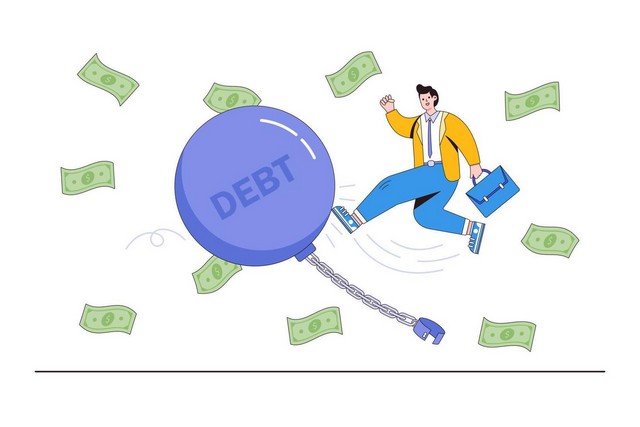Get Out Of Debt Loans: A Path to Financial Freedom?
Debt can be a heavy burden, impacting your mental health, relationships, and overall well-being. For many, "get out of debt loans" seems like a lifeline.
 |
| (Picture: vecteezy.com) |
These loans, often called debt consolidation loans, aim to simplify your finances by combining multiple high-interest debts into a single, more manageable loan. But are they indeed a solution, or just a temporary fix?
What are Get Out of Debt Loans?
Essentially, a get-out-of-debt loan is a personal loan used to pay off existing debts, such as credit card balances, medical bills, or other personal loans.
The appeal lies in consolidating these debts into one loan with a potentially lower interest rate and a fixed monthly payment.
How They Work:
- Application and Approval: You apply for a personal loan from a bank, credit union, or online lender. The lender assesses your creditworthiness and determines the loan amount and interest rate.
- Debt Payoff: If approved, the loan proceeds are used to pay off your debts.
- Single Monthly Payment: You then make a single monthly payment to the new lender, simplifying your repayment process.
Potential Benefits:
- Lower Interest Rates: If you qualify for a lower interest rate than your current debts, you can save money on interest over the loan's term.
- Simplified Payments: Consolidating multiple debts into one payment can make budgeting easier and reduce the risk of missed payments.
- Improved Credit Score: Consistently making on-time payments on a consolidation loan can positively impact your credit score over time.
- Clear Repayment Timeline: A fixed repayment schedule provides a clear end date for your debt, offering a sense of control.
Potential Risks and Considerations:
- Not a Magic Bullet: A get-out-of-debt loan doesn't eliminate the underlying problem of overspending. It's crucial to address the root causes of your debt.
- Potential for Higher Overall Cost: Although the monthly payment may be lower, a longer loan term could result in paying more interest over the life of the loan.
- Credit Score Impact: If you have poor credit, you may not qualify for a low-interest loan or may be offered a loan with unfavorable terms.
- Fees and Penalties: Some lenders may charge origination fees, prepayment penalties, or other hidden costs.
- Secured vs. Unsecured: Secured loans, which require collateral, pose the risk of losing your assets if you default. Unsecured loans, while not requiring collateral, often have higher interest rates.
Alternatives to Consider:
- Debt Management Plans (DMPs): Offered by credit counseling agencies, DMPs involve negotiating lower interest rates and payments with your creditors.
- Balance Transfer Credit Cards: These cards offer introductory 0% APR periods, allowing you to transfer existing balances and pay them off interest-free. However, be aware of balance transfer fees and the end of the introductory period.
- Negotiating with Creditors: You can try negotiating directly with your creditors for lower interest rates or payment plans.
- Budgeting and Lifestyle Changes: Creating a budget and making necessary lifestyle changes are essential for long-term debt management.
Conclusion:
Get-out-of-debt loans can be a useful tool for simplifying debt repayment and potentially saving money. However, they are not a one-size-fits-all solution. Thoroughly evaluate your financial situation, compare loan offers, and consider alternative options before making a decision. Remember, addressing the underlying causes of your debt is crucial for achieving lasting financial freedom. Consulting with a financial advisor can provide personalized guidance and help you make informed choices.

0 Response to "Get Out Of Debt Loans: A Path to Financial Freedom?"
Post a Comment